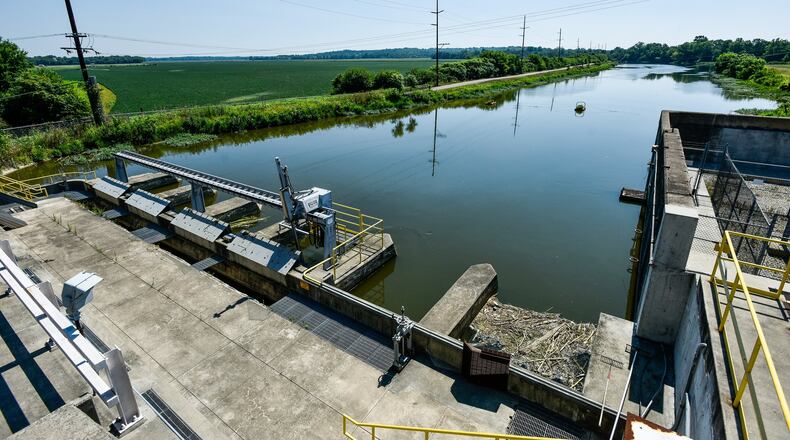The industrialist’s Ford & Son Co. bought the hydroelectric plant, which had opened in the mid-1840s, during July 1918, according to a column by the late Hamilton historian and former Journal-News editor Jim Blount.
Today, Hamilton officials hope that tiny hydroelectric plant and its two much larger city-owned counterparts on the Ohio River will continue to attract companies, including those from Europe, where there is more of a premium for hydroelectric and other renewable-electricity sources.
One unnamed company that Hamilton officials hope to announce this summer probably would not be coming to the city if not for its hydroelectric energy, City Manager Joshua Smith recently said.
Before Henry Ford arrived, the hydroelectric plant had powered more than a dozen businesses, including large paper mills.
Ford didn’t come to Hamilton to build cars. Instead, Ford and his son, Edsel Ford, arrived in town, purchased the hydroelectric plant for about $200,000, and built a $2 million factory to manufacture Fordson tractors that would sell for about $700 apiece.
Production started May 13, 1920, at the nearby Ford Tractor Building, where eventually 600 men were building 400 tractor transmissions per day, according to “Beyond the Model T: The Other Ventures of Henry Ford,” written by Ford R. Bryan.
The facility is the reason the northern-Hamilton neighborhood was named Fordson Heights.
Within two years, the plant was building Model T automobile wheels. By late 1928, the plant instead was building all-steel Model A wheels, according to the Ford R. Bryan book. Ford sold the factory to Bendix Aviation Corp. in June, 1951.
After Bendix left the city in 1963, the city of Hamilton bought the hydroelectric plant. It later added two far larger ones on the Ohio River — during the early 1980s, the Greenup hydroelectric plant near Vanceburg, Ky.; and this decade, the hydroelectric generator at the Meldahl locks and dam.
The hydroelectric plant is located along a canal that receives water from the Great Miami and then returns water there. On Friday, it was producing 1.1 megawatts of power, with a constant whir that could be heard outside the facility that on the inside resembled a large basement, but with big cabinets of heavy-duty electrical equipment.
Water, falling about three stories’ height, was spinning blades attached to a turbine at about 162 rotations per minute. The facility’s generators were upgraded during the 1990s from earlier technology.
When it’s operating at its 2 megawatt capacity, it generates enough energy to power 400 homes.
By comparison, the gigantic Meldahl facility produces a 105 megawatts of power, while Greenup’s capacity is 70.2 megawatts.
The small hydro plant captures the imagination of city employees like Electric Power Systems Superintendent Dennis Farthing, and others familiar with its history.
“It’s a wonderful thing to be able to keep something running, surviving, and being useful to us for all these years,” Farthing said. “I think it’s a tribute to the forefathers and the thought they put into how things were put together.”
Farthing said he was inspired by “the inventive spirit of someone to take something, and make something out of nothing — it’s like you start at zero, and you walk away, and you’ve made a plant that makes electricity. That’s fascinating.”
The future may be a lot like the past, where that original hydroelectric plant caused manufacturers to build factories near it, city officials believe.
Smith recently told Dan Hurley on WVXU-FM’s Cincinnati Edition that green power can grab companies’ attention.
Smith said he and others were meeting with a German automotive company in Atlanta.
“We were going through the reasons why they should be in Hamilton. I felt they weren’t even paying attention up until the point we got to our hydros, and the fact that we could certify that 100 percent of the power that they consumed would be green. And that certainly caught their attention,” he said.
That reaction varies by companies, city leaders have noted. Economic Development Director Jody Gunderson noted that European firms tend to be more conscious of environmental concerns, perhaps because their energy was more expensive for decades than here in the United States, and other factors.
“We’re going to have a job announcement probably come out in the next 60 days, publicly, and but for having the green energy, I don’t think they would have chosen Hamilton,” Smith told Hurley.
The Journal-News previously has reported that iMFLUX Inc., Procter & Gamble’s plastics-innovation subsidiary, took up the city on its ability to “formally certify to iMFLUX that all of the electric energy consumed by iMFLUX in their operations shall be 100 percent Green Energy.”
For companies like iMFLUX and ThyssenKrupp Bilstein of America Inc., which makes high-tech shock absorbers for vehicles, “this is a big deal to them,” Smith told Hurley. The fact Hamilton also owns its own natural gas utility as well as electric, water and sewers, also allows it to lower companies’ utility rates as an incentive.
Because of its electric operations, the city allows companies to connect not only to its electric production and distribution system, but also to Duke Energy, which serves those beyond city boundaries, so electricity continues to flow when one producer has a blackout.
There may be even more hydroelectric power on the way for Hamilton.
Another Hamilton company has been investigating putting yet other hydroelectric generators, capable of creating 5 megawatts, where the low-level dam south of Hamilton’s downtown now is located.
The replacement low-level dam and generators, which require licensing from two federal agencies, would be less dangerous for boaters, advocates believe.
About the Author
